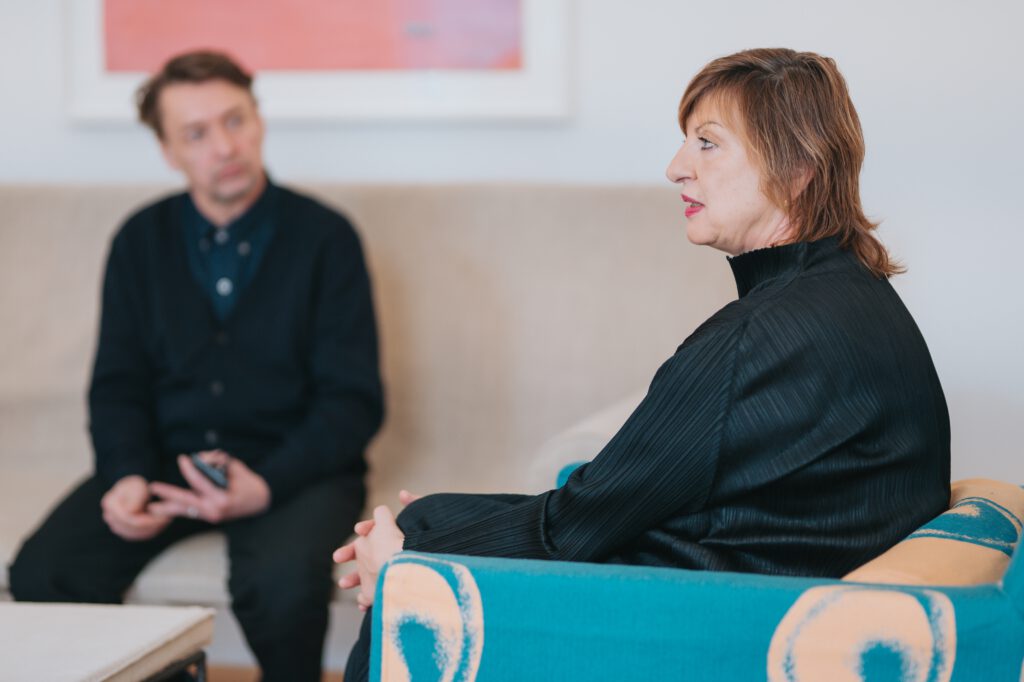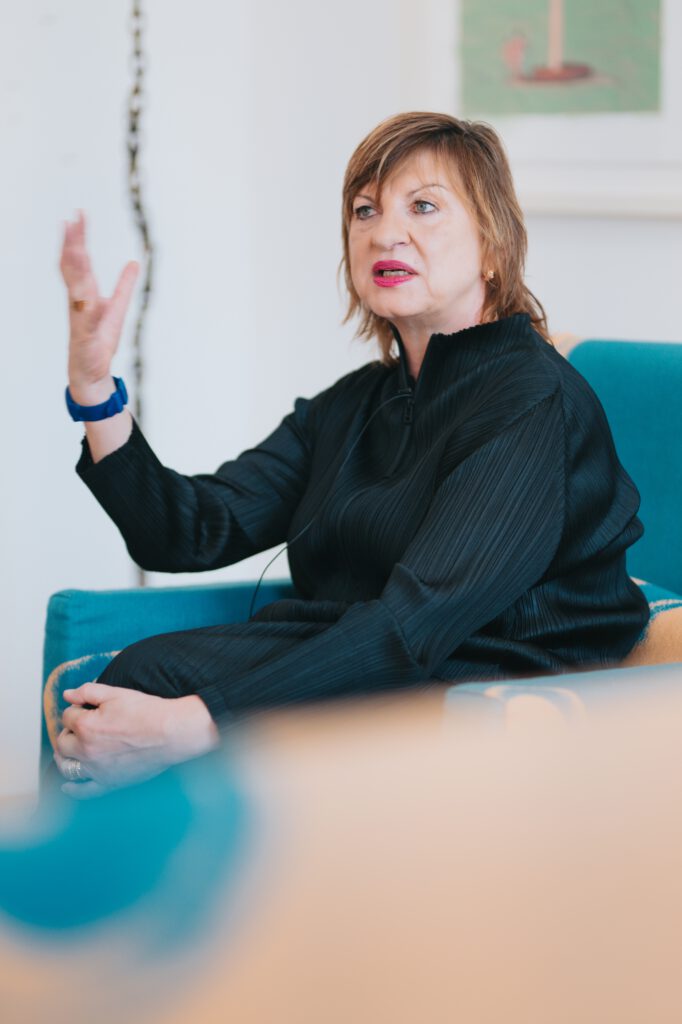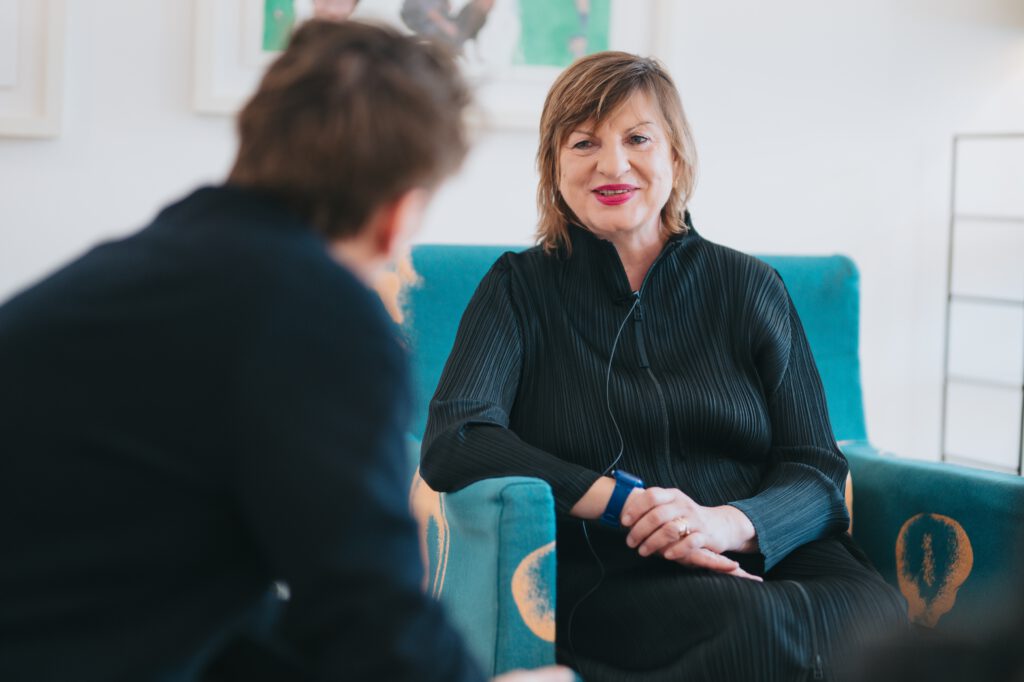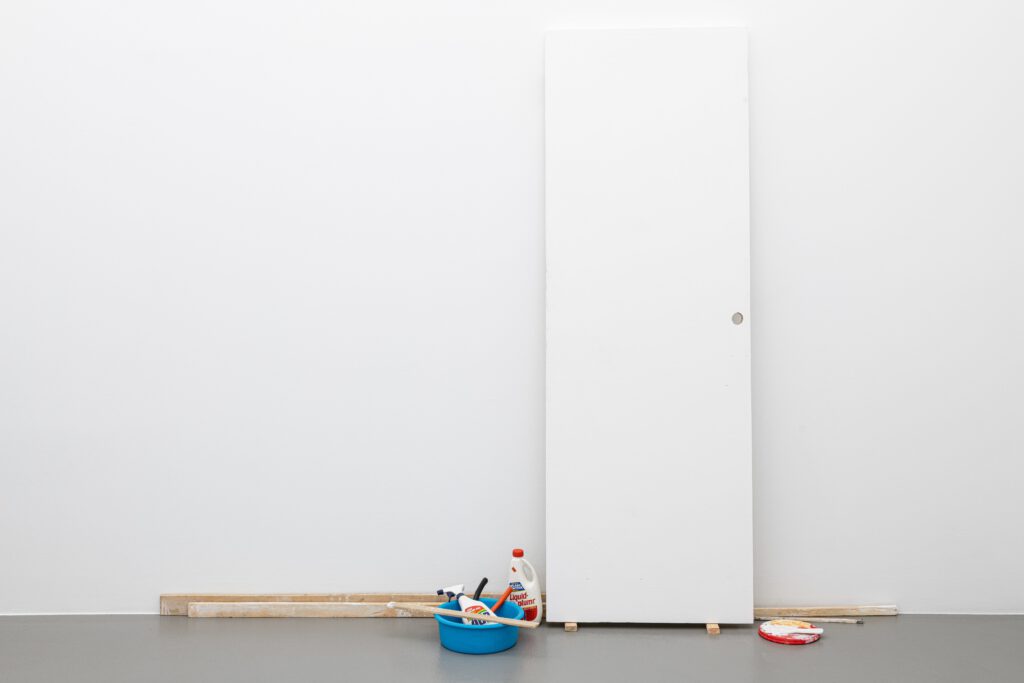In Dialogue | Eva Presenhuber
Eva Presenhuber Gallery
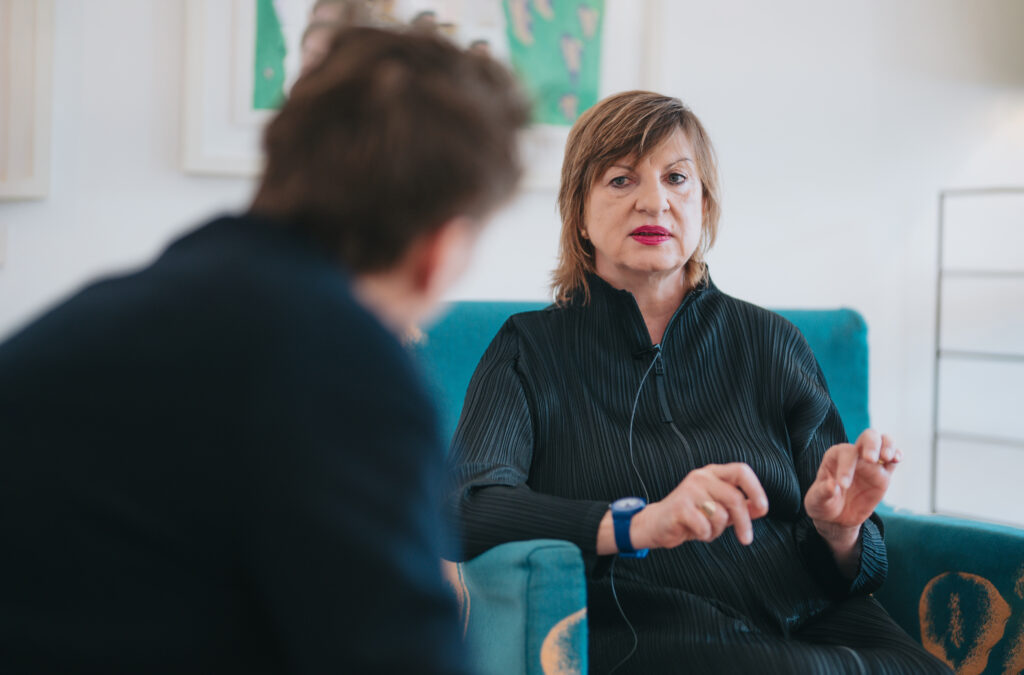
viennacontemporary Artistic Director Boris Ondreička met gallerist Eva Presenhuber, who, after pioneering the art scene in Zürich and New York, has now returned to her homeland Austria and opened a gallery space in Vienna.
Boris Ondreička: Maybe we start at the beginning – what is your background?
Eva Presenhuber: I actually studied art myself, at the University of Applied Arts Vienna, starting off in the class of Oswald Oberhuber and then finishing with Ernst Caramelle.
Do you still have some of the works in your archives?
Not in my archives (laughs), but my cousin and another person, who both purchased works from me when I was still studying, have it on their walls.
What kind of art did you make?
I basically tried to copy other artists I admired (laughs). This brought me of course to the conclusion that I am not a real artist, so I just finished my studies and seized the chance to do something else with my education.
So you went from being an active artist to supporting artists.
I was never an active artist. I was an art student during the 80ies, and before I visited a ceramics school in Stoob and Graz. It was a long process, but it was worth it because I learned that I am good at talking about art and convincing people. When I did my degree, I decided that I wanted to do a curated show instead of a final presentation, and instead of showing my own works, I presented another artist. I liked curating – already in 1988, I curated a big group show called “Melencolia” at Grita Insam, which was a big success – but they did not let me curate a group show for the degree.
Whose art did you present?
I borrowed works from Ugo Rondinone, who was a fellow student. He gave me chairs in 50ies style painted in various shades of grey, kind of futuristic. It was an early work he did during his studies – and with that work, I graduated. Telling you this now, I hope I don’t have to return the diploma (laughs). It’s a story I always want to tell, because it is such an incredible, generous gesture of Rondinone, who had been my friend already for some years at the time, giving me his work to pursue my degree and then telling me: “You should become my gallerist! Why don’t you open a gallery in Zurich?” This thought was a big relief – not to have to think about doing arts myself anymore. And that’s how it happened. The Walcheturm was my first proper job.
I actually visited it in 1991 and I still remember you there.
It was a great, beautiful space in a wonderful building – a government building from the 30ies. They were looking for a gallerist with ideas for programs, so I applied for the job. It was an open call and I applied, like many others, and I think because I had done this group show at Insam and I had just finished school, they gave me the job. This was my first eight years of building up a program.
And then we reach the shift from nonprofit to profit…
It was always profit, because there was no money (laughs). Luckily the rent was only CHF 1.000, and even 35 years ago this was very cheap for Switzerland, which made me survive somehow, and thank God, I then met a big collector who started to collect my program: Franz Wassmer, who had been a big Dieter Roth collector for many years in Switzerland already – that really saved me over the eight years.
In Walcheturm, the financing was from selling?
Eva Presenhuber: There was no financing really. After a year, I built a new board that was very successful because I got some great people like Andi Stutz from Fabric Frontline, Peter Nople, a very well-known, very good lawyer, Beat Kurti, a big industrialist who collected, Franz Wassmer, who collected in-depth. And in 1996, I met Hans-Ulrich Obrist with his school friend Iwan Wirth, who came to the board too. Iwan was very much connected, especially to his now mother-in-law, Ursula Hauser, who was supporting him, because he was really young and she believed in him, and Ursula started to buy works from Franz West, Fischli / Weiss, and many others. And this brought the gallery to the next step, Fischli / Weiss showed in my gallery in 92, Ugo in 90, Urs Fischer in 96, Franz West in 95, Pipilotti Rist… so I was very lucky to do a program very early with heavy hitters. Even though the very young artists among them were not heavy hitters at that time, they were just very ambitious, and I knew that! The others, like Fischli / Weiss and Jean-Frédéric Schnyder, and Ugo Rondinone gave me a very good reputation in the country. I was really active in Switzerland for years, I went to every opening in Geneva, Bern, Basel. It was fun! It was the time when contemporary art in Zürich became more important and many new galleries opened, as well as Kunsthalle Zürich.
Also, remember the apartment exhibitions?
The apartment exhibitions I don’t remember so well, but there were also these illegal bars… But the opening of Kunsthalle was really a key moment in the early 90ies to change the city’s landscape for contemporary art. I was lucky enough to start in a great period, which was super exciting. In 1998, Iwan said he would open a gallery with Ursula and his wife Manuela, so I offered to add my program if I could have a separate space to do it. It went great for five years, until I did not want to be an employee and got out with my program.
This is when you founded LISTE?
I actually had the idea for LISTE already in ‘96 when we did not get into Art Basel with Walcheturm– which I understand better now, I mean we were too young you know (laughs). There was an art fair in Cologne, called Unfair, so I proposed to do the same. The graphic designer I engaged – who is actually a gallerist in Zürich now – named it LISTE.
Why the name LISTE?
LISTE because you are on a kind of waiting list for a certain time, in this case for Art Basel. I was a bit afraid that we would get punished by the fair by getting banned, but they were quite accommodating. Then, however, after the first LISTE, they saw the potential of having a second fair because especially younger galleries didn’t bother so much for Art Basel. So they founded a new format to get in younger galleries, with smaller booths, solo shows, and projects.
So it was a huge success?
In the first edition of LISTE, David Zwirner was there, Gavin Brown, Galerie Neugerriemschneider, everybody was there you know. I said to Art Basel: “As long as you don’t have anyone from the younger generation on the board you will not understand them.” So they asked me who they should get on the board – it was Pierre Huber, who asked me – and I said take Esther Schipper. So they did. She was the one who made this new format happen and I think this really changed Art Basel in the right time. In the late 90ies and early 2000s, there was a big generational shift of artists and galleries and Art Basel understood this and reacted correctly. LISTE still exists, because it is nice for galleries to be seen and benefit from a place where so many collectors and curators come together. It is a beautiful fair. Peter Bläuer, who I knew from earlier on as he had done a big group show including Fischli / Weiss and Ugo Rondinone, he lived in Basel, so he found the first space for LISTE and then ran it. We gave it to him; we didn’t even take any shares or anything.
In 2003 you founded your own gallery. So are you celebrating your 20iest gallery anniversary this year?
To me, it seems that I’m rather celebrating more than 35 years (laughs). I mean, I was not always having my own gallery, but I was always running my own program, so to me, that’s not such a big difference. Of course, it was a good move to open up my own space and when I saw that the artists all came with me in 2003, it made me very happy – and that also gave the gallery a good reputation because it showed continuity.
Today, you are running four spaces in three cities and represent at least 46 artists. That’s a huge logistical effort; how do you manage this monumental structure?
We have a great team, which is mainly based in Zürich. We have about 20 people sitting there, technicians, bookkeepers, transportation, archive, PR, interns, and salespeople, and the gallery here has three people working permanently. In New York, I had four people working permanently, but we are closing the space there now. I think we have done a very good job for the many young artists who didn’t have galleries in New York before – now they do. This was the goal, and we did shows we wanted to do, you cannot repeat this anymore. I think the city has served us well, and now we continue and concentrate more on Asia: we have some shows in Seoul, where we have got a small space that was offered to us. Now we are free to invest a little more energy there and in our Vienna gallery.
And you returned to Vienna as well!
Yeah, that was the pandemic time. I had thought about it before sometimes and even looked for spaces in Vienna to rent, and every time I would see an even bigger space on the next corner the following year, but I was like, “No, no, no, don’t do that.” We never had many collectors from Vienna, and very few sales, so we knew we couldn’t make money here, but the city has an atmosphere that I like, of course, because I’m from Austria and I like being in Vienna. My sisters and my mother are here. My friend George, who lives in LA, also loves the city because he grew up here as a child because his father was at the UN. So, I thought I should be here more – and having a gallery here seemed a good reason. Actually, it doesn’t bring me here that often, but now we have it. During the pandemic I saw this space, it was manageable, so I took it, and then this apartment became available too, so we said let’s take it too, so we have more space.
Are you a collector yourself as well?
Well, as most gallerists do, I buy art. Either you do it because you haven’t sold enough and the artist needs money, or you have to or want to do it because you like the artist and know it’s a good investment or something you “should” have because it might be good for you later. Or you buy at an auction because you have to support it to protect the artist. Or you’ve put a lot of production costs into an artist, and you can’t get them back, so you have to trade them for works. So, there are a lot of reasons why collections come together. Yeah, I have a nice collection by now.
Do you have any advice for young or future gallerists?
There is no other way than to be very honest in your program, and if you are talented enough, young artists who are also talented will come to you. Great artists find good gallerists, and it’s not a good idea to mix too much or become too commercial because great artists won’t like that. You have to find your community. The best way is to start with artists from your own neighborhood. If you are in Vienna, start with Austrian artists, I mean there are so many. Then try to grow slowly and steadily by being admired for your program.
Any advice for us as an art fair?
I think you are doing a good job with the Eastern countries. You bring the countries and people around Austria together, that was the core idea. Of course, Eastern countries suffer a little bit more than Western countries like France, Germany, or Switzerland, because they have less institutional and gallery support and less interest from the market. Just take the best galleries you can get!
You are currently presenting Fischli / Weiss in your Vienna gallery; it is beautifully installed. Can you tell us a bit more about that? You have a long history with those artists, do you have a personal attachment to the exhibition?
Of course, if you work with such famous and great artists for so many years – from 1992 to now – makes you also grow old together. We have done many exhibitions together, many institutional shows, more than many artists usually do. I am very grateful that we still work together. Unfortunately, David Weiss passed away in 2012, the same year as Franz West. We work with the estate, which is represented by Peter Fischli and David Weiss’ children. We are three galleries that run the estate and now we are more active again with gallery shows and institutional shows, because their last big show was at the Guggenheim Museum and there was also a show at the Beyeler Foundation. With Peter Fischli we had an exhibition in Zurich last year, with the airports and cars, which went very well, and so I asked him if he wanted to do an exhibition in Vienna since Fischli / Weiss showed here last 25 years ago. Peter Fischli said let’s do the polyurethane objects…. that’s how it came together.
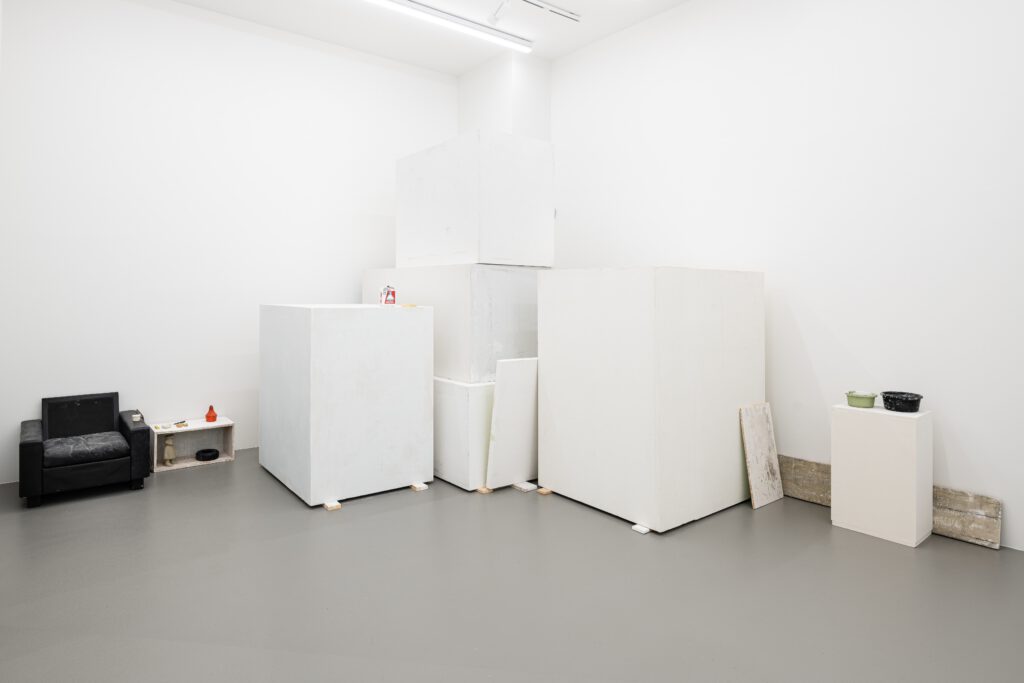
Installation view, Peter Fischli David Weiss, Polyurethane Objects, Galerie Eva Presenhuber, Vienna, 2023

